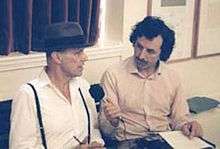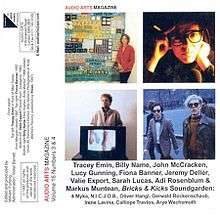Audio Arts
Audio Arts was a British sound magazine published on audio cassettes, documenting contemporary artistic activity via artist or curator interviews, sound performances or sound art by artists.

History
The project was launched in 1973 by Barry Barker and British sculptor William Furlong, born 1944 in Woking, Great Britain. From 1973 to 2006, Audio Arts published 25 volumes of 4 issues of the Audio Arts Cassettes (later releasing LPs and CDs as well). Furlong conducted all interviews until 1996, when Jean Wainwright took the baton as interviewer. Each interview starts with I am here with..., stating artist's name and recording location. Interviewees include: Andy Warhol, Anish Kapoor, Joseph Beuys, Gilbert & George, Yoko Ono, R. Buckminster Fuller, Hermann Nitsch, Mario Merz, Gerhard Richter, Nam June Paik, as well as an interview with WB Yeats' daughter and readings by Yeats himself (in Vol.1 Issue #4, 1974).
William Furlong was part of a generation of British artists of the 1960s-70s including Gilbert & George, Richard Hamilton, Bruce McLean or Paul Richards (whose Nice Style performance group was the first pose band) who were consciously moving from traditional art forms to conceptual art, performance, new media, cheap materials, in a dematerialized and process-oriented ethos.[1] Furlong is now a sound artist with sound installations exhibited in Lisbon (Walls of Sound, 1998), Bexhill on Sea, Sussex (Anthem, 2009), Genillard Gallery, London (Possibility & Impossibility of Fixing Meaning, 2009).

With the acquisition of the Audio Arts archive by Tate in 2004 (itself a long-time subscriber to Audio Arts cassettes releases), over 200 boxes of master tapes used to edit the magazine are now secured for future researchers. A selection was exhibited at Tate Britain March–August 2007. The archive is now catalogued, digitized[2] and preserved there.[3]
In October–December 2006, a retrospective exhibition curated by Lucia Farinati took place at Rome’s Sound Art Museum showing a selection of Audio Arts releases and adding a new sound art by Furlong: Conversation Pieces, a reworking/remixing of preview Furlong interviews, making famous interviewees respond to each other by the magic of cut-up. See SlashSeconds.org.
William Furlong's Audio Arts project was featured in the See This Sound (Promises in Sound and Vision) exhibition, curated by Cosima Rainer, August 28, 2009 to January 10, 2010, Lentos Kunstmuseum, Linz, Austria.[4]
The cassette medium
Like other audio magazine publishers,[5] William Furlong took full advantage of the cassette medium as the most efficient way to spread his material the world over. The cassette was indeed the most pertinent medium for various reasons:
- easy copy on demand and cheap postage reduced production costs ;
- Furlong considered lengthy interviews as an equivalent to conceptual art and language-based art ;
- Furlong considered the cassette as an 'organic sculpture' in itself.
Some of the interviewees were themselves great defenders of the cassette medium, like Lawrence Weiner and Dieter Roth. In an interview with Ilari Valbonesi, Furlong says he considered the cassette medium as a radical form of communication back in 1973.[6] What he means by radical can be figured out from this Jean Wainwright recollection:
"I am reminded of Vito Acconci's work Face Off (1973) where he listens attentively to his own-recorded voice on an audio tape player telling of extremely intimate moments in his life. When the confessional material becomes too highly charged for him he cries out over the taped voice, 'no don't tell this, don't reveal this,' his dramatic response to his conflicting drives between self-revelation and self-concealment."[7]
Footnotes
- Information from Heidi Grundmann's essay featured in the See This Sound (Promises in Sound and Vision) catalogue published by Verlag der Buchhandlung Walther König, Köln, Germany, 2009. Catalogue supervised by Cosima Rainer, Stella Rollig, Dieter Daniels and Manuela Ammer.
- "Audio Arts".
- Maynard, Jack; Foster, Alison (2012-10-01). "Preserving the Audio Arts Archive". Journal of Conservation and Museum Studies. 10 (1): 59–63. doi:10.5334/jcms.1011209.
- See official website
- Like Joseph Nechvatal's Tellus Audio Cassette Magazine or Tina Pearson's Musicworks cassettes
- "Archived copy". Archived from the original on 2008-05-15. Retrieved 2008-09-27.CS1 maint: archived copy as title (link)
- http://www.axisweb.org/dlFULL.aspx?ESSAYID=40/%5B%5D
Sources
- Audio Arts digitised and published on the Tate website
- Bill Furlong Audio Arts: Discourse & Practice in Contemporary Art, published by Academy Editions, London, 1994.
- Overview and index of the Audio Arts releases
- Bill Furlong interview
- Bill Furlong biography